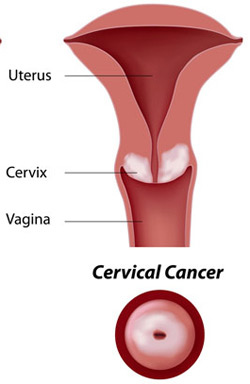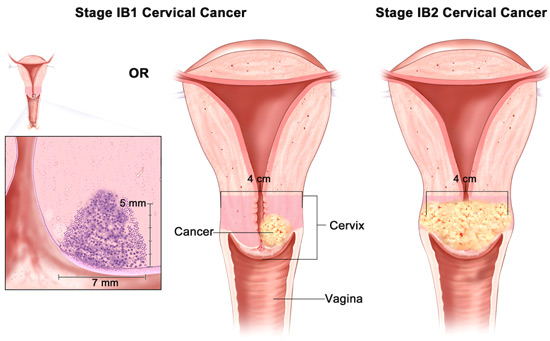Cervical cancer occurring coincident with pregnancy is, fortunately, quite rare, probably less than 1 in 10,000 pregnancies.

Pregnancy and cervical cancer can be categorized under two categories for a better understanding.
- Being pregnant when you are diagnosed
- Pregnancy after treatment for cervical cancer
Being Pregnant When Diagnosed:
A small number of cervical cancers are found in pregnant women. The decision to go for the pregnancy or its termination will depend on the stage of pregnancy and cervical cancer. For example, If your cancer is a very early cancer, such as stage IA, then most doctors believe that it is safe to continue the pregnancy to term. Several weeks after delivery, a hysterectomy or a cone biopsy is recommended (the cone biopsy is suggested only for substage IA1). He/She might recommend:
- A cesarean section followed by hysterectomy for delivery and treatment, or
- A vaginal delivery with hysterectomy several weeks later.
If a pregnant woman has advanced cervical cancer, she and her partner, together with the physician, must decide whether to continue or terminate the pregnancy. Immediate treatment is the safest option for a pregnant woman with advanced cervical cancer.
If you are less than three months pregnant, your doctor may want to treat you straight away. Your doctor may feel more than six months is too long to leave an invasive cancer without treatment. If you do have treatment then your pregnancy will be ended.
Pregnancy After Treatment for Cervical Cancer:
Unfortunately, after most treatment for cervical cancer, you cannot get pregnant. This is because either you have had your womb removed (if you have had surgery). Or your ovaries will have stopped working (if you have had radiotherapy).
If you have very, very early cervical cancer, you may be able to have a cone biopsy. This would mean you can still get pregnant and have a baby because your womb is still intact. Your doctor will take into account your wishes to become pregnant in the future.
It will only be safe to have a cone biopsy if
 The cancer cells are only in the cervix itself
The cancer cells are only in the cervix itself- The cancer is less than 3-5mm deep into the tissue of the cervix
- The area affected is no bigger than 10mm across at any point
- There is absolutely no sign of any cancer in a blood vessel, lymphatic vessel or lymph gland
- Unless all these conditions are met, there is too big a risk that the cancer could come back.
Radical Trachelectomy
The other option is, called radical trachelectomy. This is a way of removing an early cancer, but leaving enough of the cervix behind to support a pregnancy. During the treatment most of the cervix is removed, but the womb and the upper opening of the cervix (where it joins onto the womb) are left behind. The surgeon will put a stitch around the upper opening of the cervix to hold it closed. This means that there is a reasonable chance that you would be able to become pregnant. This operation has been available in some centres for 5 – 10 years and babies have been born safely to women who have had it done. There is a significant risk of miscarriage or premature birth because the cervix may not be able to support the weight of the growing pregnancy. The babies have to be born by Caesarean section because the cervix is permanently stitched closed after the trachelectomy.
This type of treatment can only be done if you have a very early cervical cancer – no more than a small stage 1 cancer. You are more likely to be able to have this operation with a stage 1A than a stage 1B cancer. The surgeon will not be able to guarantee success before the operation. Before the operation, it isn’t possible to tell how far up the cervix the cancer cells have spread. The tissue that is removed has to be checked for cancer cells while you are under anaesthetic. There is always the risk that more tissue will have to be removed to cure the cancer and so the cervix cannot be saved.
If your surgeon finds you have a stage 1B cervical cancer, he or she will want to remove some of your lymph nodes as well as the cancer. This is to check that there are no cancer cells that have broken away from the cancer and lodged in the lymph nodes around the womb. If there are, and these are not treated, the cancer is likely to come back.
With a stage 1 cancer, there is only a small risk of cancer spread to the lymph nodes. But if any of your lymph nodes are found to contain cancer cells, your specialist is likely to recommend radiotherapy. Unfortunately, radiotherapy will also make you infertile and so you will not be able to have children even after the trachelectomy.
During pregnancy, decisions regarding the use of radiological investigations must take into account the age of the fetus and the estimated dose of radiation delivered with the respective imaging study. In the pregnant patient, ultrasound and MRI should be considered as alternatives to CT scans since both are noninvasive and are not associated with ionizing radiation |
Stages of Cervical Cancer and Treatment:
The following stages are used for cervical cancer:
- Stage 0 (Carcinoma in Situ) In stage 0, the cancer is found in the first layer of cells lining the cervix only and has not invaded the deeper tissues of the cervix. Stage 0 is also called carcinoma in situ.
- Stage I In stage I, cancer is found in the cervix only. Stage I is divided into stages IA and IB, based on the amount of cancer that is found.
• Stage IA: A very small amount of cancer that can only be seen with a microscope is found in the tissues of the cervix. The cancer is not deeper than 5 millimeters (less than ¼ inch) and not wider than 7 millimeters (about ¼ inch).
• Stage IB: In stage IB, the tumor is still within the cervix and either:
• Can only be seen with a microscope and is deeper than 5 millimeters (less than ¼ inch) or wider than 7 millimeters (about ¼ inch); or
• Can be seen without a microscope and may be larger than 4 centimeters (about 1 ½ inches)
- Stage II
In stage II, cancer has spread beyond the cervix but not to the pelvic wall. Stage II is divided into stages IIA and IIB, based on how far the cancer has spread from the cervix into nearby tissue.
• Stage IIA: Cancer has spread beyond the cervix to the upper two thirds of the vagina but not to tissues around the uterus.
• Stage IIB: Cancer has spread beyond the cervix to the upper two thirds of the vagina and to the tissues around the uterus.
- Stage III
In stage III, cancer has spread to the lower third of the vagina and may have spread to the pelvic wall and nearby lymph nodes. Stage III is divided into stages IIIA and IIIB, based on how far the cancer has spread.
• Stage IIIA: Cancer cells have spread to the lower third of the vagina but not to the pelvic wall.
• Stage IIIB: Cancer cells have spread to the pelvic wall and/or the tumor has become large enough to block the ureters. This blockage can cause the kidneys to enlarge or stop working. Cancer cells may also have spread to lymph nodes in the pelvis. - Stage IV
In stage IV, cancer has spread to the bladder, rectum, or other parts of the body. Stage IV is divided into stages IVA and IVB, based on where the cancer is found.
• Stage IVA: Cancer has spread to the bladder or rectal wall and may have spread to lymph nodes in the pelvis.
• Stage IVB: Cancer has spread beyond the pelvis and pelvic lymph nodes to other places in the body, such as the abdomen, liver, intestinal tract, or lungs.
Treatment Options By Stage
- Stage 0 Cervical Cancer (Carcinoma in Situ)

• Loop electrosurgical excision procedure (LEEP).
• Laser surgery.
• Conization.
• Cryosurgery.
• Hysterectomy for women who cannot or no longer want to have children.
• Internal radiation therapy for women who cannot have surgery. - Stage IA Cervical Cancer
• Hysterectomy with or without bilateral salpingo-oophorectomy.
• Conization.
• Radical hysterectomy and removal of lymph nodes.
• Internal radiation therapy.
- Stage IB Cervical Cancer
• A combination of internal radiation therapy and external radiation therapy.
• Radical hysterectomy and removal of lymph nodes.
• Radical hysterectomy and removal of lymph nodes followed by radiation therapy plus chemotherapy.
• Radiation therapy plus chemotherapy.
• A clinical trial of high-dose internal radiation therapy combined with external radiation therapy.This summary section refers to specific treatments under study in clinical trials, but it may not mention every new treatment being studied. Information about ongoing clinical trials is available from the NCI Cancer.gov Web site.
- Stage IIA Cervical Cancer
• A combination of internal radiation therapy and external radiation therapy.
•Radical hysterectomy and removal of lymph nodes.
• Radical hysterectomy and removal of lymph nodes followed by radiation therapy plus chemotherapy.
• Radiation therapy plus chemotherapy.
• A clinical trial of high-dose internal radiation therapy combined with external radiation therapy.This summary section refers to specific treatments under study in clinical trials, but it may not mention every new treatment being studied. Information about ongoing clinical trials is available from the NCI Cancer.gov Web site.
- Stage IIB Cervical Cancer
Internal and external radiation therapy combined with chemotherapy. - Stage III Cervical Cancer
Internal and external radiation therapy combined with chemotherapy. - Stage IVA Cervical Cancer
Internal and external radiation therapy combined with chemotherapy. -
Stage IVB Cervical Cancer
• Radiation therapy as palliative therapy to relieve symptoms caused by the cancer and improve quality of life.
• Chemotherapy.
• Clinical trials of new anticancer drugs or drug combinations.
Disclaimer
The Content is not intended to be a substitute for professional medical advice, diagnosis, or treatment. Always seek the advice of your physician or other qualified health provider with any questions you may have regarding a medical condition.




